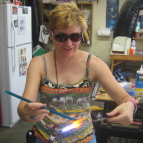AACtual Therapy: Teaching the Use of Social Phrases and Comments

We are so happy to have Deanna Wagner back with more AACtual Therapy. In her previous post, Deanna talked about her work with AAC  groups for adults. Today, she shares a lesson plan and some implementation ideas. As a veteran AAC interventionist, Deanna’s therapy plan has many wonderful features that undoubtedly contribute to the success her students experience.
groups for adults. Today, she shares a lesson plan and some implementation ideas. As a veteran AAC interventionist, Deanna’s therapy plan has many wonderful features that undoubtedly contribute to the success her students experience.
![]()
Lesson/therapy Session: Using Social Phrases/Comments
Intended audience & type of AAC: All devices/AAC users should have access to social commenting.
Our Class: Middle school, self-contained classroom. Group of 3 students, SLP leading activity, paraprofessional, and Teacher of Visually Impaired supporting
Goal for Overall Lesson: Use word/icon combinations to express opinions or make social comments
Specific Student Goals:
- Student #1 will combine 2 icons for social interjections – please, thank you, cool, awesome, yum, yuk, ok (ECO2 from PRC)
- Student #2 will functionally use new phrases to chat or indicate an opinion (Dynavox Vmax with scanning)
- Student #3 will interact/participate for a variety of purposes, including comments (give positive/negative opinion) (Dynavox EyeMax)
Materials: Websites with sound effects were used to elicit responses
- http://www.annbrundigestudio.com/2012/10/24/the-haunted-castle/
- http://www.partnersinrhyme.com/soundfx/scary_halloween_sounds.shtml
Background Knowledge: We have been practicing rating stories after we read them on www.TarheelReader.com. This website provides prompts at the end of each story to rate with stars. Now we will have an opportunity to make similar ratings with additional comments following a listening activity.
Activity: The three device users are positioned in front of the SmartBoard, with two teachers between them. The SLP uses a laptop connected to the SmartBoard to launch the Haunted Castle activity previously downloaded. The haunted castle is displayed and we talk about how some people like to hear scary sounds and some people don’t. After the first scary sound, the activity is paused and the teachers model their opinions using the student communication devices first. After that, teachers primarily act as facilitators/communication assistants, helping a little with navigation and quiet prompting using an agreed-upon chain of cues. We continue playing the sounds in the Haunted Castle, not worrying about which rooms we enter or what images we see, but focusing primarily on the eerie sounds. We then continue onto another website with sound effects, again looking for comments from the students. As students comment, the group leader (SLP) reflects out loud on their opinions. Number of words used by students were automatically recorded on the Dynavox devices using usage counts and on the PRC device using the Language Activity Monitor (data logging). At the end of the session students and teachers were reminded that they can give opinions during many different activities, including reading/writing responses.
Impressions: We had a lot of fun with this activity. One of the teachers consistently shared (first on an AAC device and later using her speech and body language) that she did not like scary sounds. One of the students in particular (Student #3) laughed at the teacher and kept repeating on her device that the sounds were “awesome” and affirming, “I like that.” She is the youngest in the group and tends to wear frilly dresses and pretty pink outfits. We actually were concerned that she might be afraid. It was very eye-opening to watch her attention riveted on the haunted castle scene and her delighted responses to the sounds. The other two students basically complied with the activity, but didn’t respond as much as Student #3.
For more information/ideas about active listening and commenting, take a look at these Tips from Caroline Musselwhite’s AAC intervention website:
Filed under: PrAACtical Thinking
Tagged With: AACtual therapy, commenting, Deanna Wagner, lesson plan, middle school, social phrases
This post was written by Carole Zangari





3 Comments
Love this activity, Deanna! Thanks for sharing!!
WONDERFUL post, Deanna! Thanks for bringing Deanna to us, Carole and Robin! I will be sure to share this well-developed and well-explained lesson plan with our teachers and SLPs!!
-Lauren
This so so helpful! Thank you for a wonderful resource.